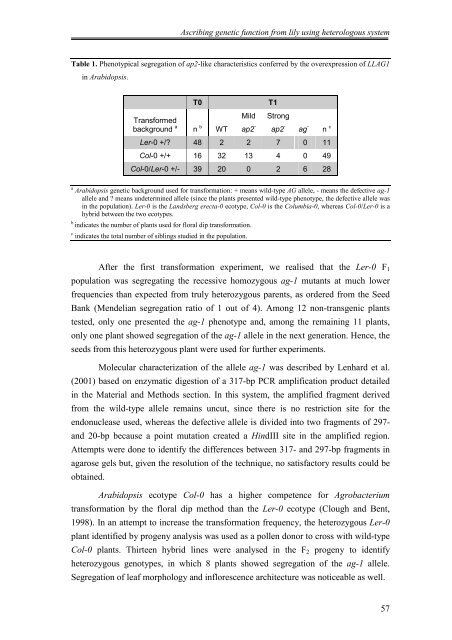Flower development of Lilium longiflorum - The Lilium information ...
Flower development of Lilium longiflorum - The Lilium information ...
Flower development of Lilium longiflorum - The Lilium information ...
Create successful ePaper yourself
Turn your PDF publications into a flip-book with our unique Google optimized e-Paper software.
Ascribing genetic function from lily using heterologous system<br />
Table 1. Phenotypical segregation <strong>of</strong> ap2-like characteristics conferred by the overexpression <strong>of</strong> LLAG1<br />
in Arabidopsis.<br />
Transformed<br />
background a<br />
T0 T1<br />
n b WT<br />
Mild<br />
ap2 -<br />
Strong<br />
ap2 -<br />
ag - n c<br />
Ler-0 +/? 48 2 2 7 0 11<br />
Col-0 +/+ 16 32 13 4 0 49<br />
Col-0/Ler-0 +/- 39 20 0 2 6 28<br />
a Arabidopsis genetic background used for transformation: + means wild-type AG allele, - means the defective ag-1<br />
allele and ? means undetermined allele (since the plants presented wild-type phenotype, the defective allele was<br />
in the population). Ler-0 is the Landsberg erecta-0 ecotype, Col-0 is the Columbia-0, whereas Col-0/Ler-0 is a<br />
hybrid between the two ecotypes.<br />
b indicates the number <strong>of</strong> plants used for floral dip transformation.<br />
c indicates the total number <strong>of</strong> siblings studied in the population.<br />
After the first transformation experiment, we realised that the Ler-0 F1<br />
population was segregating the recessive homozygous ag-1 mutants at much lower<br />
frequencies than expected from truly heterozygous parents, as ordered from the Seed<br />
Bank (Mendelian segregation ratio <strong>of</strong> 1 out <strong>of</strong> 4). Among 12 non-transgenic plants<br />
tested, only one presented the ag-1 phenotype and, among the remaining 11 plants,<br />
only one plant showed segregation <strong>of</strong> the ag-1 allele in the next generation. Hence, the<br />
seeds from this heterozygous plant were used for further experiments.<br />
Molecular characterization <strong>of</strong> the allele ag-1 was described by Lenhard et al.<br />
(2001) based on enzymatic digestion <strong>of</strong> a 317-bp PCR amplification product detailed<br />
in the Material and Methods section. In this system, the amplified fragment derived<br />
from the wild-type allele remains uncut, since there is no restriction site for the<br />
endonuclease used, whereas the defective allele is divided into two fragments <strong>of</strong> 297-<br />
and 20-bp because a point mutation created a HindIII site in the amplified region.<br />
Attempts were done to identify the differences between 317- and 297-bp fragments in<br />
agarose gels but, given the resolution <strong>of</strong> the technique, no satisfactory results could be<br />
obtained.<br />
Arabidopsis ecotype Col-0 has a higher competence for Agrobacterium<br />
transformation by the floral dip method than the Ler-0 ecotype (Clough and Bent,<br />
1998). In an attempt to increase the transformation frequency, the heterozygous Ler-0<br />
plant identified by progeny analysis was used as a pollen donor to cross with wild-type<br />
Col-0 plants. Thirteen hybrid lines were analysed in the F2 progeny to identify<br />
heterozygous genotypes, in which 8 plants showed segregation <strong>of</strong> the ag-1 allele.<br />
Segregation <strong>of</strong> leaf morphology and inflorescence architecture was noticeable as well.<br />
57














